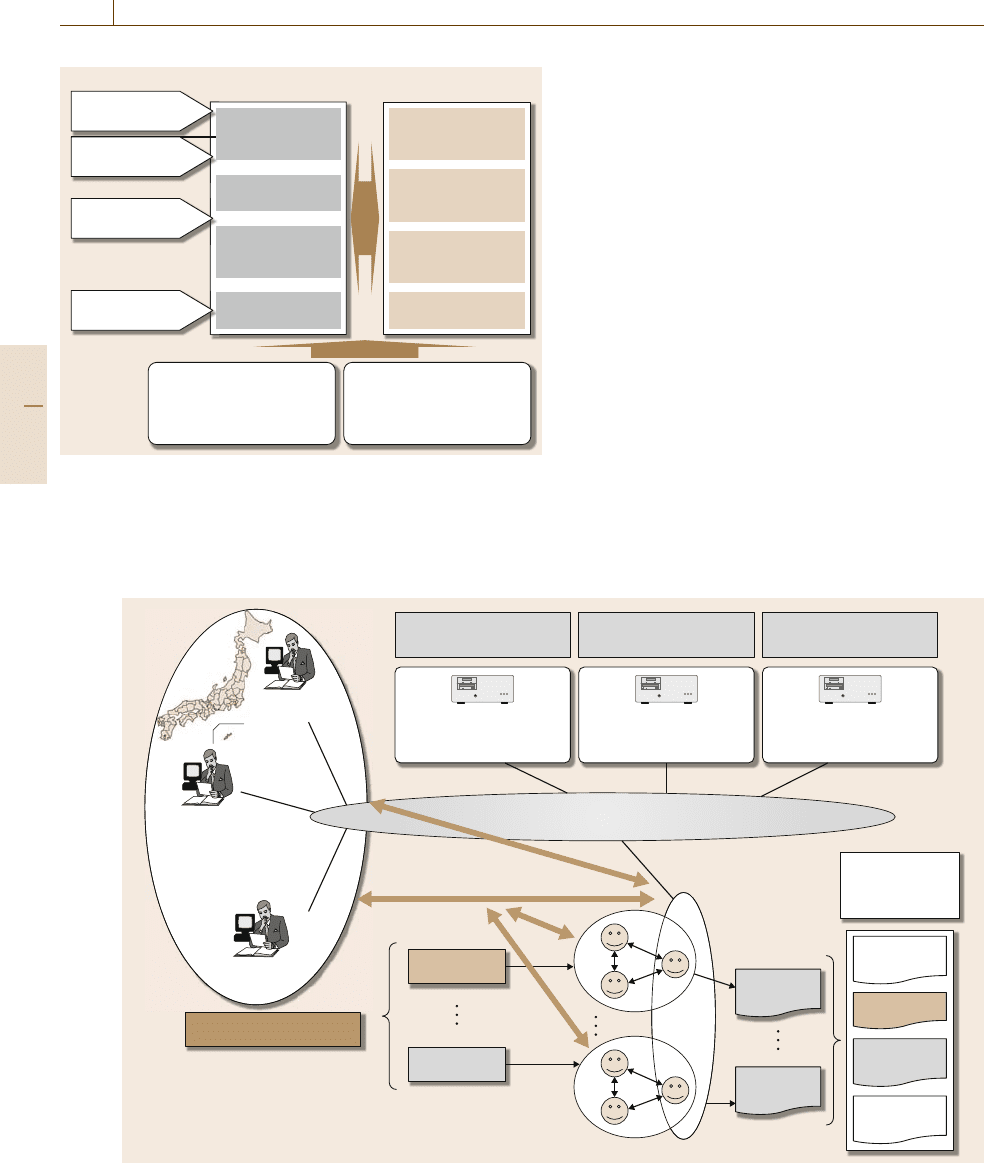Nof S.Y. Springer Handbook of Automation
Подождите немного. Документ загружается.


Automation in Education/Learning Systems 85.1 Technology Aspects of Education/Learning Systems 1505
Table 85.1 Instructional design process model and its operations and methods
Management circle ADDIE model Operations and methods
Plan Analysis Needs analysis
Job analysis
Student analysis
Design [85.15,16] Determination of learning goals
(target behaviors, evaluation conditions, achievement levels)
Structuring Determination of learning contents
Sequencing (knowledge, skills, values) [85.14,17–21]
Programming Determination of learning methods
[85.22,23] considering student characteristics
Determination of provision methods
(joint training/individual training)
× (cost performance)
Development Textbooks
[85.24–27] Multimedia materials (in-house or consigned development)
audiovisual +interactive
Do Implementation Tutoring
[85.28–35] Mentoring
Check/act (see) Evaluation Evaluation subject Learner
Program
Evaluation method Formative evaluations
[85.36–41] + comprehensive evaluations
Reaction/learning/behavior/results
Analysis
The purpose of analysis is to extract useful informa-
tion on what the parties are attempting to teach for
setting learning goals. Analysis results directly affect
the content of the structuring and sequencing, which
are the next stages in the design process. To begin
with, needs analyses are conducted to determine what
instructors and learners are seeking (what they want
to achieve), and to clarify the social trends, human
resources development strategies, educational plans, ca-
reer designs, and other assumptions, as well as the
limiting conditions on the educational resources avail-
able for use. When the learners are adults, job analyses
may also be conducted to identify the required com-
petencies [85.42] from work duties content analysis. It
is also necessary to conduct student analyses to clar-
ify learners’ academic history, experience, and learning
preferences.
Design Process
Most of the debates regarding ID largely focus on the
design process, with two different system approaches
to ID. The Reigeluth approach [85.15] divides system
design factors into three categories:
1. Learning conditions (learning issues, student char-
acteristics, learning environment, etc.)
2. Learning methods (learning contents compilation
methods, implementation methods, evaluation im-
provement methods, etc.)
3. Learning results (results, efficiency attractiveness,
etc.).
Then, the combinations of the categories are clas-
sified into descriptive theory and prescriptive theory
depending on what are cause factors and effects factors.
The Rickey approach [85.16] combines an inductive
Part I 85.1

1506 Part I Home, Office, and Enterprise Automation
approach with a deductive approach by experts, with
interesting discussions of conceptual versus procedural
models.
In the design process, the learning goals clarified by
analysis are subdivided to the level at which they can
be measured, followed by the step of structuring, which
structures the relative priorities among the subdivided
goals, and sequencing, which determines the learning
order and contents to achieve the goals considering
learner characteristics and improvement of education
results and efficiency. Refer to Gagne [85.17], Reige-
luth [85.18, 19], Merrill [85.20], Sato [85.21], and
Akahori [85.14] for detailed discussions of these issues.
Models and methodologiesadopting their research find-
ings provide an extremely valuable framework for the
fusion of education/learning activities with information
technology.
Educational programs are then compiled, consider-
ing the learning goals, learning content, and learning
formats (group or individual), and synchronous or asyn-
chronous learning as well as the limitations on time
and educational resources. Some examples of the learn-
ing formats are shown in Fig. 85.2 in which formats
are classified into distance learning [85.44] or not, and
self-directed learning or not.
ID researchis also being advanced by Keller [85.22]
and Suzuki [85.23] on the attention, relevance, con-
fidence, satisfaction (ARCS)modelasameansof
motivating learners by creating more attractive educa-
tion and learning environments.
Collaborative learning
Video on demand
Web-based training
Computer-based training
Synchronous
classroom learning by
internet
Distance learning by space
collaboration system
Non-distance learning
Self-directed learning
Classroom learning
Distance learning
Fig. 85.2 Some examples of learning formats (after [85.43], with permission from Ohmsha, 2002)
Development
Development sets the educational units via the fol-
lowing considerations on the series of learning
goals and learning contents generated by the design
works [85.13]:
1. Selection of learning goals
2. Listing of instructional events
3. Selection and development of educational materials
and learning activities
4. Division of rules between instructors and learners.
Among these, the core task is the selection and
development of educational materials, for which the
potential applications of ICT and other multimedia
and digital technologies have been greatly increas-
ing in recent years. Prior to the arrival of this new
era, Gagne [85.13] recognized and made an interest-
ing suggestion that computers and other new media are
significant for education not just because they enable
stimulating presentations as instructional events but be-
cause they are important factors for improving learning
results, effectiveness, and attractiveness.
Active learning [85.24] has also been gaining at-
tention as a new trend in educational methodology
development, primarily in the business world. The case
study, scenario, and simulation methods are represen-
tative examples of active learning, and these include
the goal-based scenario (GBS) theory advocated by
Shank [85.26] for the scenario methods. GBS is an ID
Part I 85.1

Automation in Education/Learning Systems 85.1 Technology Aspects of Education/Learning Systems 1507
theory for developing scenarios as a learning environ-
ment to provide students with vicarious experience of
learning from failure, using actual cases from business
literature [85.27,28].
Implementation
Various communication channels are formed by the
student learning environment at this stage, where the
designed instructional content is implemented. The
challenge for these channels is to realize system de-
sign and operation that holds and increases the learner’s
interest. From a learner-centered perspective, the chan-
nel formation factors include the human factors of
instructors, mentors, tutors, other learners, and educa-
tional materials distributors and the material factors of
computers, media displays, and educational materials
distribution systems. The materials factors mostly con-
cern the design of the man–machine interface.
However as the learning activities themselves are
fundamentally human activities, the issue of the au-
tomation of education/learning activities assuming an
advanced information society brings us to reconsider
the definition of what constitutes a human being. In that
sense, such questions as instructor competency [85.28]
and presence [85.29–31], how to make learners actively
involved with instruction administration [85.32, 33],
and psychological aspects [85.34, 35] will be impor-
tant issues for future examinations on the automation
of education/learning activities.
Evaluation
Kirkpatrick [85.36] provides a typical four-stage ID
evaluation model. This model divides evaluation of the
development and implementation of education/learning
systems into the four levels of reaction, learning, be-
havior, and results. It clarifies the evaluation period and
evaluation items, as well as the data collection, mea-
surement, and evaluation methods. This model gives
consideration to e-Learning, for example, in the han-
dling of return on investment, which is a level 4 results
evaluation item [85.37, 38]. Formative or comprehen-
sive evaluation methods may also be used, depending
upon the evaluation objective [85.39]. Comprehen-
sive evaluations provide an overall evaluation of the
learning effect after a series of learning activities
is completed. Formative evaluations [85.40, 41] are
evaluations conducted during the learning process for
the purpose of improving the education and learning
activities.
85.1.2 Development History
and Present Conditions
of e-Learning
In this section we address e-Learning as an educa-
tion/learning systems automation topic, and review
the peripheral technologies, development history, and
present conditions of e-Learning.
Definitions of e-Learning
Definitions of e-Learning are extremely diverse, and
have changed over time. Sample definitions include the
following:
•
American Society for Training and Development
(ASTD) [85.45]:
e-Learning refers to all items provided, facilitated
or transmitted by electronic technology that are
clearly for the purpose of learning.
•
Broadbent [85.46]:
Computerization is important for e-Learning.
e-Learning means computerized training, educa-
tion, coaching, and information, and includes
synchronous and asynchronous learning that is
assisted by technologies such as the internet, CD-
ROMs, satellites, telephones, personal computers,
PDAs and other wireless equipment, multimedia,
and CBT.
•
Rosenberg [85.47]:
e-Learning refers to the provision of diverse so-
lutions using internet technologies to heighten
knowledge and performance.
•
The Japan e-Learning consortium (JeLC) [85.48]:
e-Learning is independent learning using informa-
tion technologies and communications networks.
The contents are arranged in line with the learn-
ing goals, and interactivity is secured as necessary
between the learner and the contents provider. This
interactivity gives the learner opportunities to par-
ticipate at will, so appropriate instruction can be
given at appropriate timeswhile advancing learning
through people and computers.
Part I 85.1

1508 Part I Home, Office, and Enterprise Automation
e-Learning Peripheral Technologies
Because e-Learning is based on information and com-
munications technology, it encompasses diverse learn-
ing formats which can be categorized by the following
distinctive characteristics:
1. Educational materialsand their distribution methods
2. Communication between instructors and learners.
In characterizing (1), the extent to which the
learning is electronic can be measured by the comput-
erization of the contents and distribution. e-Learning
where the contents used as educational materials are
more computerized and the distribution involves less
human intervention is considered to be more electronic.
In characterizing (2), Fig.85.3 positions e-Learning
with greater potential for two-way communications
as having a higher level for interactivity. This fig-
ure was prepared by the Japan e-Learning Consortium
(JeLC) [85.48],and partiallyrevisedby the authors. The
items marked by solid circles denote those character-
ized as e-Learning. Videos are considered a borderline
area because of the existence of both digital and analog
videos. From this figure, we project that the devel-
CD-ROM/DVD self-learning/
computer-based training
Receipt of e-Mail questions on
educational materials distribution
TV conference
system synchronous
remote instruction
Space collaboration
system
Correspondence
education
Video on demand
Face-to-face teaching
Publications
Television/
radio
broadcasting
Facsimile
transmission
education
Video
e-Learning
Out of e-Learning
Web-based training
Personal digital assistant
Low
Interactivity
Level of computerization
Low
High
High
Fig. 85.3 Range of e-Learning by level of computerization and interactivity (after [85.48, p. 9], with permission from
Tokyo Denki Univ. Press, 2007)
opment of future e-Learning technologies will move
toward higher levels of computerization and interactiv-
ity under lower cost.
The History of Problem Solving
and Value Creation in the Development
of Computer-Assisted Education/
Learning Systems
Reviewing prior efforts to use computers in educa-
tion/learning systems, the fusion of problem-solving
needs at learning and education sites with the seeds
of instructional design theory can be recorded as the
history of advancing automation using computer and
communications technologies. Table 85.2 presents the
history of problem solving from computer-assisted
(aided) instruction (CAI) through to e-Learning, ex-
plaining the problems, solutions, and main technolo-
gies involved. Table 85.2 compares e-Learning with
CAI, CBT, and web-based training (WBT), but the
e-Learning system involves CAI, CBT and WBT as
a whole as shown in Fig.85.2 and its definitions.
Among the various e-Learning stakeholders, Ta-
ble 85.3 examines the learner, instructor, and training
Part I 85.1

Automation in Education/Learning Systems 85.1 Technology Aspects of Education/Learning Systems 1509
Table 85.2 History of problem solving in computer-assisted education/learning systems (
a
The use of PDAs and cell phones is
included)
Name Problems to be solved Solution Automation
elements
CAI: computer- Money and time are required for the Display learning contents Computer
assisted (aided) following items using conventional in accordance with the level
instruction systems: of understanding of each learner,
• Instructors and learners must be and save money and time
at the same location for long via computer assistance
periods of time
• Learners’ progress and other
items must be compiled manually
CBT: computer- Learning order is determined Educational materials compiled CD-ROM
based training beforehand by manuals in CAI, into a database, allowing interactive Personal computer
so learners cannot freely choose setting of learning order
learning order
WBT:web- CBT has the following problems: Educational materials are transmitted Internet-WWW
based training • Unified management of learners’ via networks, facilitating quick
progress not possible revisions and learning evaluation
• Educational materials cost money Materials can be used for both
• Educational materials changes synchronous and asynchronous
and improvements are difficult learning
e-Learning WBT has the difficulty Learners can study independently, LMS,
of compiling optimal learning plans making maximum use of the potential m-Learning
a
from the perspectives of results, of information and communications
efficiency, and attractiveness technologies to meet individual
considering learners’ academic learning needs
history and progress, etc.
manager and identifies the value creation in terms of
cost, time, and quality.
e-Learning Platforms and Standards
The platforms and standards for e-Learning systems
are another technical aspect which supports e-Learning.
The development and spread of these technologies have
facilitated the low-cost development of e-Learning sys-
tems with consistent quality, and greatly contributed
to the spread of e-Learning. The spread of e-Learning
systems also advances the further development and evo-
lution of e-Learning systems.
Table 85.4 summarizes the platforms and stan-
dards for learning management systems (LMS) [85.49],
which constitute the core of e-Learning systems.
LMS are platforms which provide such functions as
educational materials management, learning progress
management, learning implementation phase manage-
ment such as management of mentoring and tutor-
ing, and testing phase support for question setting,
grading, performance results processing, and contents
creation.
Learning contents management systems (LCMS)
are primarily platforms to support educational mater-
Part I 85.1

1510 Part I Home, Office, and Enterprise Automation
Table 85.3 Value creation by e-Learning
Value/ Learner Instructor Training manager
stakeholder
Cost reduction Educational materials receipt Educational materials distribution Indirect cost
expenses expenses
Time efficiency Faster acquisition of materials Faster learning results feedback Faster system
and learning results performance management
Quality Permits acquisition of the most Permits preparation of the most Accumulation
improvement recent educational materials recent educational materials of study
Permits repeated study (review) Accumulation of study history data history data
Allows control over learning Uniform distribution of the same
pace educational materials
Table 85.4 e-Learning platforms and standards/tools (LCMS – learning content management system, LMS – learning manage-
ment system, SCORM – sharable content object reference model, CMI – computer-managed instruction, LOM – learning object
metadata/learning object reference model, LIP – learner information package, QTI – question and test interoperability, SSO –
single sign-on)
ADDIE model Platform Function Standards/tools
SCORM [85.50] LIP QTI SSO
CMI LOM [85.51,52]
[85.53]
Analysis – –
Development LCMS Authoring [85.54,55]
Accumulation [85.56]
and management
of educational
materials
Implementation LMS Learning management
[85.57,58] Learner management
Educational materials [85.56]
distribution
Progress management
Contents creation [85.56]
support
Communications
Mentoring
Tutoring
Evaluation Testing
Part I 85.1

Automation in Education/Learning Systems 85.2 Examples 1511
ials developers. These platforms offer the two functions
of authoring, which are the compilation and produc-
tion of educational materials, and educational materials
database management.
The sharable content object reference model
(SCORM) in the “standards/tools” column is a web-
based training (WBT)standard that integrates computer-
managed instruction (CMI) with the learning object
metadata/learning object reference model (LOM) stan-
dards, which are learning resource data structure
standards. The LOM standards are used to describe the
attributes of learning objects, which comprise all re-
sources used in learning.
The learning information package (LIP) standards
are used to describe the attributes of learners. The
question and test interoperability (QTI) standards cover
the necessary information for implementing tests. Sin-
gle sign-on (SSO) is an e-Learning system technology
which allows learners to log in once and gain access to
library information systems, academic affairs manage-
ment systems, and various other existing systems and
resources aside from the LMS.
In 2005 the Organization for Economic Coop-
eration and Development (OECD) conducted a sur-
vey among institutions of higher education world-
wide [85.59] regarding the conditions of e-Learning.
Respondents noted the difficulty of assuring the quality
of e-Learning [85.60], along with various other issues
such as difficulty using present technologies [85.61],
and problems with creating, selecting, and using learn-
ing objects [85.57]. Considering these evaluations,
the present platforms and standards technologies are
immature, but should serve as the basis for future devel-
opment. Researchprojects on developing architecture to
break down LMS componentsinto modulesand restruc-
ture the LMS e-Learning architecture in accordance
with work flow include the MIT Open Knowledge
Initiative [85.58] and the e-Framework [85.62]being
jointly developed by the UK and Australia. The other
projects for e-Learning in USA and Europe may be
found at [85.63–67].
e-Learning may be classified into synchronous
and asynchronous learning. In asynchronous learn-
ing, learners communicate individually with computer
systems such as WBT. In synchronous learning, mul-
tiple learners communicate among themselves or one
or more learners communicate with a tutor or men-
tor under a computer-supported collaborative learning
(CSCL) environment. Synchronous learning is simi-
lar to small-group kaizen (continuous improvement)
activities in Japan. The platforms for collaborative
e-Learning are still being established. CSCL is defined
by Koschmann [85.68] as a field of study centrally
concerned with meaning and the practices of meaning-
making in the context of joint activity, and the ways in
which these practices are mediated through designed
artifacts. Interested readers should refer for details
to [85.50–56].
85.2 Examples
This section introduces two examples of the devel-
opment of education/learning systems in Japan based
on kaizen (continuous improvement) knowhow in the
Japanese manufacturing industry [85.69–72]. One is
a program for understanding the mechanism of engi-
neering and management of issues according to the
general product lifecycle process of the manufactur-
ing industry such as new product design, production
system engineering, production planning, production
management, supply chain management, production in-
formation management, and project management. The
other is a program for managers in leadership roles
who are contributing to creating new business value
in manufacturing technology. The both programs have
resulted from development of learning contents and nu-
merical simulation software from effective utilization of
e-Learning. The basic concept behind the both program
developed has an effective combination with an intelli-
gent knowledge-based approach [85.73] with the kaizen
activity through problem-based learning (PBL), case
method learning (CML), and computer-supported col-
laborative learning (CSCL)aswellasblended learning
combining lectures with practice.
85.2.1 Educational Programs
for Cyber Manufacturing
in Industrial Engineering
and Information Management
Overview
of the Cyber Manufacturing Program
The Research Center for e-Learning Professional Com-
petency (eLPCO) in the Research Institute of Aoyama
Gakuin University in Japan has been organizing joint
research projects between higher education institutions
and industrial corporations. A research working group
Part I 85.2

1512 Part I Home, Office, and Enterprise Automation
Engineering process
Process
engineering tool
Digital mock-up
simulation
Production line
simulation
Human work
simulation
Product design
and process
engineering (PPE)
Design for
production
system (DPS)
Layout material
handling (LMH)
Design for work
system (DWS)
Numerical simulation software
used in practice
Learning management system
(LMS)
• Practice procedure guiding function
• Numerical simulation function
• Creation of report material function
• Learning support
• Online communication function
• Learning administration function
Management process
Demand planning to
supply management
(DSM)
Agent-base
extranet
production (AEP)
Material requirements
planning (MRP)
systems
Project management
(PRJ)
Fig. 85.4 Learning map for each course unit composed of cyber
manufacturing core curricula
for cyber manufacturing has been promoted by ten uni-
versitiesand several manufactures and software vendors
Case method
learning
Blended learning
Lecture
Online
discussion
Pre & post
questionaire
Assessment
data of learning
efficacy
Practice
report
LMS
log data
Quiz
Online
discussion
Practice
* Team teaching
organization
* Role play
* Mentoring by using BBS
Learners' group*
Internet
• Face-to-face practice
• Online lecture
Problem-based
learning
• Numerical
simulation software
• Case study
• 3-D-CG simulation
Computer-supported
collaborative learning
• BBS of LMS
Aoyama Gakuin
University
Local instructor
Partnering
Universities
Fig. 85.5 Instructional strategy of comprehensive learning style combined with PBL, CML,andCSCL
as a series of eLPCO project activities. The main objec-
tive of this working group is to develop practical core
curricula in the industrial engineering and information
management field by efficiently using e-Learning meth-
ods [85.74].
As illustrated in Fig.85.4, four course units on engi-
neering processes and four course units on operational
management processes have been developed as the total
educational program for cyber manufacturing [85.75].
The characteristics of e-Learning methods for each
course are to integrate the blended-learning style be-
tween lectures and practices supported by a learning
management system (LMS) and simulation software.
Additional characteristics are treated with various in-
structional strategies such as case method learning
(CML), problem-based learning (PBL), and computer-
supported collaborative learning (CSCL).
The CML method assisted with three-dimensional
computer graphic (3-D-CG) simulationrefers toa learn-
ing method based on a case study in a virtual experience
model of the real world. Thus, by utilizing 3-D-CG sim-
ulations as shown in left arrows of Fig.85.4, practices
involving observation and process analysis of product
Part I 85.2

Automation in Education/Learning Systems 85.2 Examples 1513
Fig. 85.6 Work analysis in practice of design of work sys-
tem course unit, using task observation of moving images
of 3-D-CD human task simulation modeling
design activities and production system methods in vir-
tual factories are implemented. Some examples of the
utilization of 3-D-CG simulation in the practices in-
clude a 3-D-CG digital mock-up simulator (virtual trial
manufacturing) in the product design and process engi-
neering course unit,a 3-D-CGproduction line simulator
in the layout and material handling and design for
production system course units, and a 3-D-CG human
work simulator (Fig. 85.6)inthedesign for work system
course unit.
The aim of our PBL method is for learners to
acquire practical skills through practice by using nu-
merical simulation software. The software to support
numerical simulation and data processing is developed
by university–industry cooperation. After finishing the
theory lecture, practice is conducted by using the nu-
merical simulation software. Several practice problems
are prepared and the learners are encouraged to solve
the problems with suitable application of the learned
theories, to create more desirable solution alterna-
tives.
An LMS is a set of software tools designed
to manage user learning interventions, courses, in-
struction, content delivering, online communication,
assessment/testing, and so on. Most LMSs are web-
based to facilitate any time, any place, any pace
access to learning content and administration. The on-
line learning environment used by universities allows
instructors to manage their course and exchange infor-
mation and opinions with learners for a course that in
most cases will last several weeks and will meet sev-
eral timesduring thoseweeks. Note that basically all the
lectures and practices in the course units utilize original
LMS, developed by eLPCO under industry–university
cooperation.
New Instructional Strategy
of Comprehensive Learning Style
and Uniqueness of Lectures and Practices
As illustrated in Fig. 85.5, in order to conduct the prac-
tice corresponding to each lecture, a new instructional
strategy of comprehensive learning style is applied in
each of the course units. This is developed by com-
bining especially three types of instructional strategies:
case method learning (CML), problem-solving learning
(PBL), and computer-supported collaborative learning
(CSCL).
In all the course units, the aim of the lectures is to
understand the theoretical knowledge relating to engi-
neering and management processes, while the object of
the practices corresponding to each of the lectures is
to acquire practical skills by using 3-D-CG simulation,
numerical simulation software, and a asynchronous
bulletin-board system (BBS) communication function,
through various instruction strategies combined with
CML, PBL,andCSCL.
The reason behind the creation of this new in-
structional strategy is to achieve deeper knowledge,
while attaining practical skill, in the industrial engi-
neering and information management field, because the
conventional lecture method alone is not enough for
rudimentary learners to understand complicated engi-
neering and management processes.
Therefore, the creation of virtual images modeled
by 3-D-CG simulation, and the development of new
numerical simulation software in accordance with the
content of the practices for each of the course units,
are implemented. This has resulted in the preparation
of a practice learning environment, which is said to be
one of the most difficult environments with practical
learning to take the comprehensive learning style class
in e-Learning.
Furthermore, the characteristics of designing and
operating method of the class style, by blended learning
increase the difficulty, in which learn-by-doing instruc-
tion activities are realized by repetitive combination of
the lectures and practices.
The goal of blended learning is to synthesize learn-
ing media into an integrated mix, which can be tailored
to create a high-impact, efficient, and exciting learn-
ing program. The term blended learning is defined
as [85.76]:
Part I 85.2

1514 Part I Home, Office, and Enterprise Automation
Blended learning is the combination of different
training media (technologies, activities, and types
of events) to create an optimum training program
for a specific audience. The term blended means
that traditional instructor-led training is being sup-
plemented with other electronic formats. In the
context, blended learning programs use many dif-
ferent forms of e-Learning, perhaps complemented
with instructor-led training and other live for-
mats.
Case Method Learning (CML)
Assisted With Three-Dimensional
Computer Graphic (3-D-CG) Simulation
It is not an easy issue to educate learners who are not
able to imagine real field manufacturing and opera-
tional management at the product design and production
phases, in course units related to engineering and man-
agement processes. In particular, new learners may not
be able to understand easily the working environment,
sequences of part assembling, andhuman taskprocesses
in manufacturing factories.
Thus to make the practices based on CML more
effective, some special features are added to enrich
the practice learning environment. These features in-
clude illustrations of production procedure modeling
and realistic depictions and task analysis of virtual man-
ufacturing based on animations created using multiple
3-D-CG simulators. As illustrated in Fig. 85.6, learners
can visibly understand and analyze virtual human task
processes in an assembling production line, which are
expressed as moving images modeled by using a human
task simulator.
Fig. 85.7 Group practice using numerical simulation soft-
ware for PBL and 3D-CG simulation image of a virtual
factory for CML
Problem-Based Learning (PBL)
by Using Numerical Simulation Software
Problem-solving ability is the ability to combine previ-
ously leaned principles, procedures, declarative knowl-
edge, and cognitive strategies in a unique way within
a domain of content to solve previously unencountered
problems [85.77]. This activity yields new learning as
learners are more able to respond to problems of a sim-
ilar class in the future. This type of problem solving
is often described as domain-specific or semantically
rich problem solving because it emphasizes learning to
utilize principles in a specific content area.
Figure 85.7 shows a group practice study with nu-
merical simulation software and a 3-D-CG simulation
image of a virtual factory. The learner on the right is
observing and measuring human operating time based
on moving images from the 3-D-CD human task simu-
lation modeling illustrated in Fig.85.6. The learner on
the left is analyzing and determining standard time in
a practice from the design of work system course unit,
using the numerical simulation software.
The numerical simulation function as practical op-
eration could support learners in understanding the
application method of techniques learned by a lecture.
In addition, learners can carry out individual steps in-
volved in the practice under the guidance of instructions
on each screen of the numerical simulation software. So
the learner will be able to discover the characteristics
of the appropriate application method of the theories
and techniques by altering various parameters. The soft-
ware is also equipped with a function that automatically
processes practice data and illustrates summation tables
and analysis graphs.
Computer-Supported
Collaborative Learning (CSCL)
The last type, CSCL, is an instructional approach in
which learners of varying abilities and interests work
together in small groups to solve a problem, complete
a project or achieve a common goal [85.78]. In each
of the practices, learners, who are each given a role as
shown in Fig.85.5, are able to express their opinion
and engage in mutual communication using an asyn-
chronous bulletin-board system (BBS), installed in the
learning management system (LMS).
One advantage of the e-Learning environment is its
ability to create a kind of BBS function in the LMS to
allow learner interaction. It is possible that one learner
finds a good way to understand the theory applications
learned through the lecture and practice, or learners
want to compare the problem solution results that they
Part I 85.2
